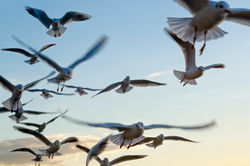San Carlos, Sonora, January 11-19, 2016
- Bill West
- Jan 31, 2016
- 2 min read
Returning to the west coast of Sonora for some mid-winter r&r has become an annual tradition. The combination of scenic bays, mangrove lined estuaries, desert arroyos and native palm slot canyons is hard to beat from a recreation and birding point of view.

The ocean regulars are always entertaining. Pacific and Common Loons feed close to shore, Blue-footed Boobies do their perfectly vertical, kamikaze dives, Brown Pelicans effortlessly skim the waves even flying into the wind, and prehistoric-looking Magnificent Frigatebirds hang high overhead, watching the terns and gulls every move, waiting for the right time to harass and plunder.
The nearby estuary hums with life forms of all kinds, not the least of which are the winged kind. American Oystercatchers with their blazing red-orange bills wait for the tide to expose their rocky feeding areas. Reddish Egrets run willy-nilly in their quest to stir up small fish. Long-billed Curlews, masters of the Western short grass prairies in the summer, switch to probing down crab holes in their winter haunts. Great Kiskadees loudly forage in the mangroves. Ospreys scan the shallows for their next meal and, when successful, retire to a nearby cactus spire to dine.
The desert birding is surprisingly diverse, especially in winter with various western US songbirds taking advantage of the frost-free conditions. Gray Vireo, Green-tailed Towhee, Cassin's, Grasshopper, and Brewer's Sparrows are among the species that find this southern portion of the Sonoran desert to their liking. Mixed in are permanent residents such as Black-tailed Gnatcatcher, Bendire's Thrasher, Gilded Flicker, and Rufous-winged Sparrow. The vocalizations and antics of the local Cactus Wrens are the signature of this habitat.
The volcanic coastal mountain ranges hold astonishing pools of water in their deeply incised canyons. Canyon Wrens reverberate the walls with their iconic songs, White-throated Swifts scour the heights for insects, and Northern Cardinals blaze the surprisingly lush understory. Montane species from the distant Sierra Madre, such as Painted Redstart, escape winter's chill by finding refuge here.
I look forward to returning to these places with clients in two months, knowing I will be treated to new sights and sounds brought by the advance of spring.




Comments